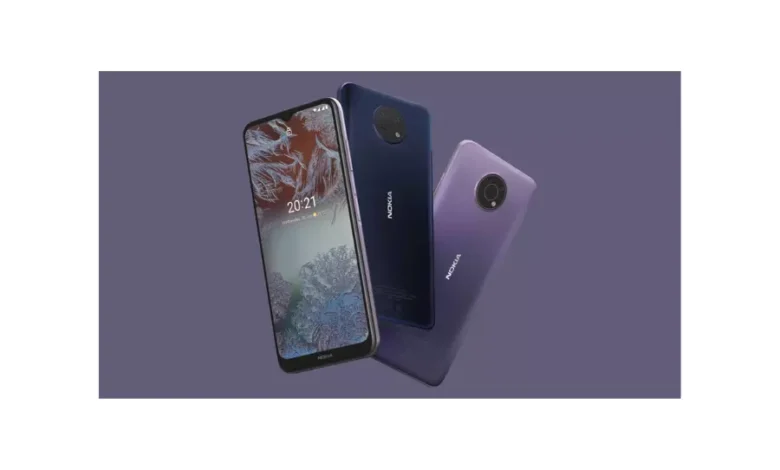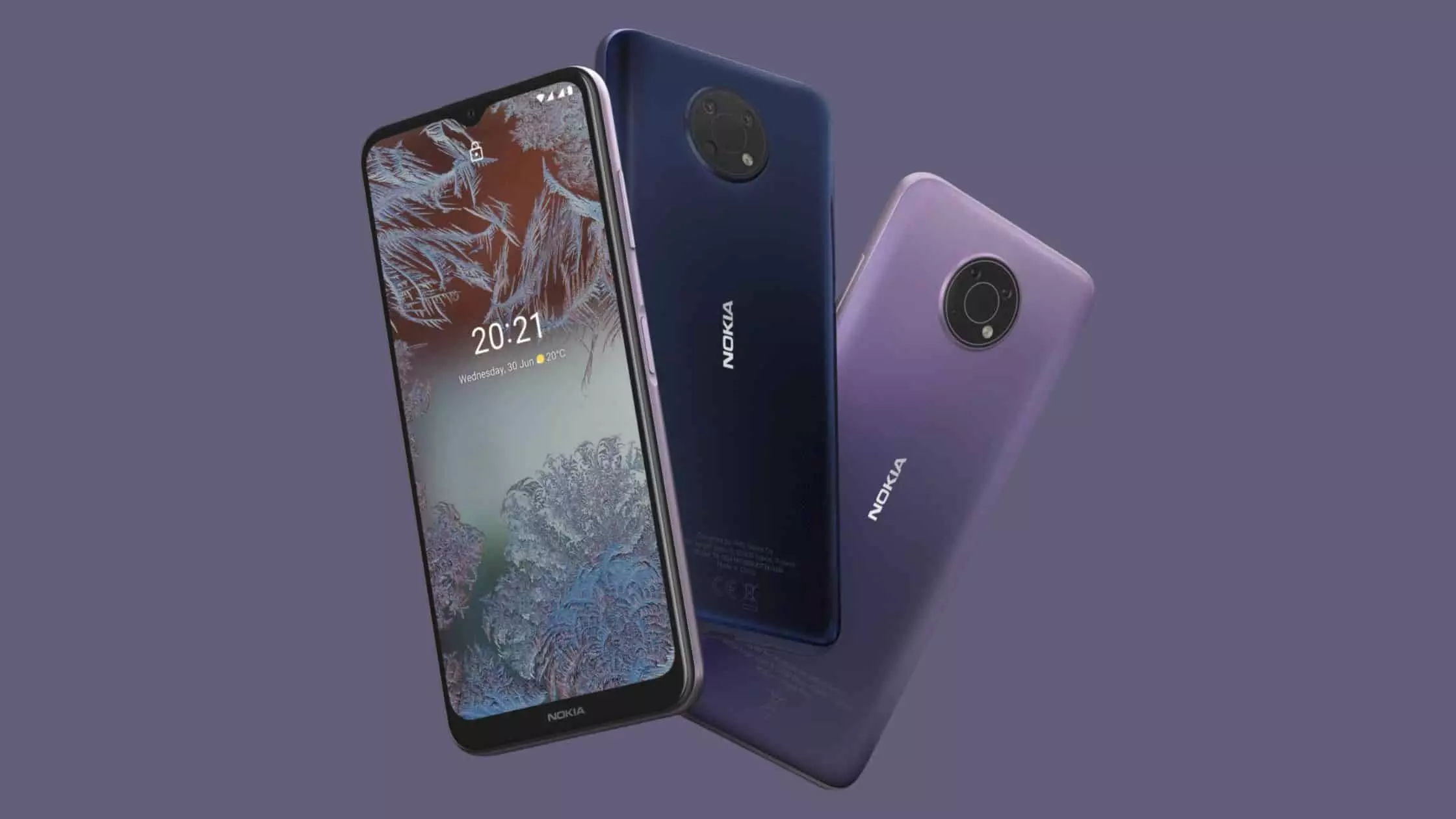

Nokia G10 Full Specifications and Price in United States, Europe and United Kingdom:
| First Release | April 26, 2021 |
| Colors | Dusk, Blue |
| Connectivity | |
|---|---|
| Network | 2G, 3G, 4G |
| SIM | Dual Nano SIM |
| WLAN | Wi-Fi direct, Wi-Fi hotspot |
| Bluetooth | v5.0, A2DP, LE |
| GPS | A-GPS, GLONASS, BDS |
| Radio | FM |
| USB | v2.0 |
| OTG | Yes |
| USB Type-C | Yes |
| Body | |
| Style | Minimal Notch |
| Material | Glass front, plastic body |
| Water Resistance | ✖ (splash-proof) |
| Dimensions | 164.9 x 76 x 9.2 millimeters |
| Weight | 194 grams |
| Display | |
| Size | 6.52 inches |
| Resolution | HD+ 720 x 1600 pixels (269 ppi) |
| Technology | IPS LCD Touchscreen |
| Protection | ✖ |
| Features | Multitouch |
| Back Camera | |
| Resolution | Triple 13+2+2 Megapixel |
| Features | Autofocus, depth, LED flash, macro, HDR & more |
| Video Recording | Full HD (1080p) |
| Front Camera | |
| Resolution | 8 Megapixel |
| Features | |
| Video Recording | Full HD (1080p) |
| Battery | |
| Type and Capacity | Lithium-polymer 5050 mAh (non-removable) |
| Fast Charging | 10W Fast Charging |
| Performance | |
| Operating System | Android 11, upgradable till Android 13 |
| Chipset | MediaTek Helio G25 (12nm) |
| RAM | 3 / 4 GB |
| Processor | Octa-core, up to 2.0 GHz |
| GPU | PowerVR GE8320 |
| Storage | |
| ROM | 32 / 64 GB |
| MicroSD Slot | Dedicated slot |
| Sound | |
| 3.5mm Jack | Yes |
| Features | Loudspeaker |
| Security | |
| Fingerprint | Side-mounted |
| Face Unlock | Yes |
| Others | |
| Notification Light | |
| Sensors | Fingerprint, Accelerometer, Proximity |
| Manufactured by | Nokia |
Nokia G10 Price in United States, Europe and United Kingdom:
| United States | $ 165.00 |
| Europe | € 155.00 |
| United Kingdom | £ 200.00 |


The Nokia G10 is a budget-friendly smartphone with powerful performance and impressive features without breaking the bank. With a large 6.52-inch HD+ display, you can enjoy watching videos and playing games on a larger screen. The phone is powered by a massive 5000mAh battery that provides all-day battery life, so you don’t have to worry about running out of juice during your busy day.
The Nokia G10 also comes with a quad-camera setup, which includes a 13MP primary camera, a 5MP ultra-wide-angle camera, a 2MP macro camera, and a 2MP depth sensor. This allows you to capture stunning photos and videos with ease. Plus, the phone supports 1080p video recording at 30fps, ensuring that your memories are captured in high quality.
Under the hood, the Nokia G10 is powered by an octa-core processor and 4GB of RAM, providing smooth and seamless performance whether you’re browsing the web, gaming, or multitasking. The phone also has 64GB of internal storage, expandable up to 512GB via microSD card, giving you plenty of space to store your favourite apps, photos, and music.
The Nokia G10 runs on Android 11 (Go edition), which means you get access to all the latest features and security updates from Google. Additionally, the phone features a rear fingerprint scanner, face unlock, and dual SIM support, making it an excellent option for those who want a reliable and affordable smartphone. Overall, the Nokia G10 is a fantastic choice for anyone looking for a budget-friendly device that still packs a punch in terms of performance and features.
Disclaimer: We can not guarantee that the information on this page is 100% correct. Read more
FAQ:
- Display: The screen display is one of the most important parts of a smartphone. It shows the user interface, apps, photos, videos, and other visual content. Displays come in different sizes, resolutions, and technologies such as LCD, OLED, AMOLED, and Retina.
- Processor: The processor is the brain of a smartphone. It handles all the calculations, operations, and tasks that the phone performs. Popular smartphone processors include Qualcomm Snapdragon, Apple A-series, and Huawei Kirin.
- RAM (Random Access Memory): RAM temporarily stores data and applications that the processor uses. More RAM means faster performance, smoother multitasking, and better gaming experience. Most smartphones have at least 4GB of RAM, but some high-end models offer up to 16GB or more.
- Storage: Smartphones have internal storage where the operating system, apps, photos, videos, and other files are stored. Some phones also have expandable storage via microSD cards. Common storage capacities range from 16GB to 512GB.
- Camera: Smartphone cameras have improved significantly over the years, offering advanced features like optical zoom, portrait mode, night mode, and video recording in 4K or higher resolution. Front cameras are typically used for selfies and face recognition.
- Battery: The battery life of a smartphone depends on various factors like screen size, processor, usage patterns, and software optimization. Many smartphones now support fast charging, wireless charging, or both. Battery capacities usually range between 2000mAh and 5000mAh.
- Operating System: The operating system manages the hardware and software resources of a smartphone. Popular smartphone OSes include Android, iOS, and Windows. Each has its unique features, app ecosystem, and user interface.
- Connectivity: Smartphones often feature multiple connectivity options like Wi-Fi, Bluetooth, NFC, GPS, and cellular networks (e.g., 4G, 5G). These allow users to access the internet, pair devices, navigate, and communicate with others.
- Audio: Smartphones may have speakers, earpieces, or headphones for audio output. Some phones also have specialized audio chipsets for enhanced sound quality or noise cancellation.
- Sensors: Various sensors inside smartphones enable features like fingerprint scanning, facial recognition, accelerometer, gyroscope, proximity detection, and ambient light measurement. These enhance user experience, security, and functionality.
- Durability: Smartphones are made with materials like glass, metal, or plastic. Some phones have IP ratings for dust and water resistance, which protect against accidental exposure to liquids or solid particles.
- Charging port: Smartphones require charging ports to replenish their batteries. Common charging ports include USB-C, Lightning (for iPhones), and Micro-USB (less common nowadays). Wireless charging pads or stands eliminate the need for cables.
- Buttons and controls: Physical buttons and touch controls facilitate navigation and operation. Common buttons include power, volume, and camera shutter release. Some phones use on-screen navigation keys or gesture-based interfaces.
- Antennas: Smartphones contain antennas for cellular communication, GPS, and Wi-Fi. They may be located at the top or bottom edges, or integrated into the device’s body.
- Fingerprint reader: Many smartphones feature fingerprint readers for biometric authentication. These can be physical buttons or optical scanners embedded under the display. Face ID systems are also becoming popular alternatives.